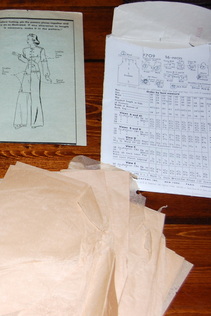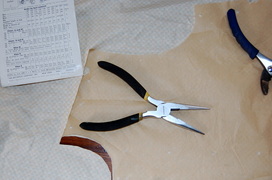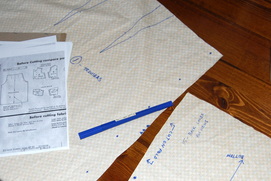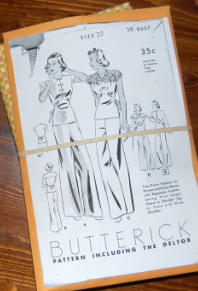
The invention of the paper tissue dress pattern is often attributed to the wonderfully named Ebenezer Butterick of Massachusetts. Way back in 1863, the enterprising Ebenezer and his wife, Ellen, began selling the first patterns available in varying sizes.
Prior to this wives and mothers (as was most often the case) had one size of pattern available to them and continually experienced the frustration of resizing before even beginning a project. As a tailor, Ebenezer was adept at custom pattern drafting and thus the modern dress pattern as we know it was born.
The first paper patterns were cut from the same tissue paper that is still being used for patterns today. Of course, back then they were cut by hand before being packaged up. The pattern pieces also had no markings other than a rather cryptic series of holes punched into the paper. The uncut, yet clearly marked, patterns as we now know them became the standard in the late 1940s.

Needless to say Butterick, a company still alive and kicking, revolutionized and economized the dress making industry. Fashion as a whole was impacted by the availabilty of size-graded patterns. While initially patterns were a luxury item (a whopping 25-75 cents in 1870), the latest styles were suddenly more accessible to the ever growing American middle class.
Working with unmarked pieces of tissue paper was a new experience for me. I don't think I have ever even held a pattern predating the 1950s.
Working with unmarked pieces of tissue paper was a new experience for me. I don't think I have ever even held a pattern predating the 1950s.

From the recently acquired Viola Collection, this particular pattern is a pajama trouser set that could only be from the 1930s. And should only ever be made from satin. Think Carole Lombard!
Utilizing Adorable Boyfriend's bike tools as weights (I'm a pin girl, but not THIS time.) I carefully cut out each piece from some old curtains I had lying around.
I meticulously marked the fabric with the proper piece numbers, darts, folds, natural waistline, and seams. I also photocopied the instruction sheet and envelope.
Utilizing Adorable Boyfriend's bike tools as weights (I'm a pin girl, but not THIS time.) I carefully cut out each piece from some old curtains I had lying around.
I meticulously marked the fabric with the proper piece numbers, darts, folds, natural waistline, and seams. I also photocopied the instruction sheet and envelope.

Although happily surprised by the wonderful condition of the pattern considering it's age (roughly 76 years old) the less I mess around with it, the better. I put away the old pattern envelope and pieces.
Once I had put all my new cloth pattern pieces in a labeled envelope, I must admit, I was quite pleased with my work. The whole thing is just such a nice, tidy little bundle.
This lounging set is the oldest pattern in the Viola Collection and so this is where I will begin. Contrary to the whole Butterick philosophy, my first step will be to resize the pattern. Woe.
Coming soon: More on Viola and the adventures of making some super slinky PJs.

 RSS Feed
RSS Feed
